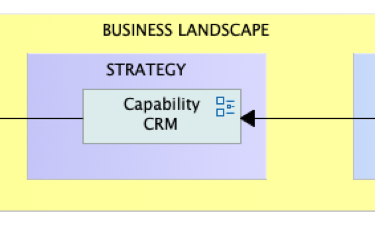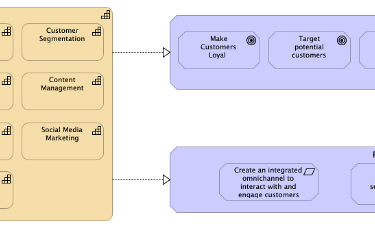Applying strategies, working with business capabilities
STRATEGYBUSINESS CAPABILITY
Alex Toguslu
10/11/2023

As enterprise and business architects, we hear often the important of business capabilities in in enhancing business strategy and execution. The capability architecture takes an important place in enterprise architecture in aligning with other facets of architecture and support the whole system in execution of business strategy.
A business capability is a combination of skills, tools, processes, and resources that groups management practices, resourcing, intelligence, and processes that coordinate and allocate tasks. A business capability is a combination of multiple attributes and properties including a perspective showing how to mobilise various elements across the organisation. Each property may come with a perspective to be used in a business function and process.
CRM (Customer Relationship Management) is a good example business capability to boost customer satisfaction, increase the customer loyalty, forecast your profitability and revenue. A CRM business capability brings many things in itself: Marketing (multi-channel campaign management, digital marketing, online marketing, digital advertising…) sales (sales automation, prospect management, opportunity management, order management…) customer insights (customer data management, customer analytics, predictive analytics…) etc. All these macro-micro capabilities have many properties mapped with various business processes.


The capability is one of the essentials elements in designing your architecture in terms of what you can do and provide. In implementing a CRM tool, with the capabilities, we can define also what we provide to the customers and users. Nowadays, the role of architectural teams focusses on helping the execution of business strategy, thus it is not only planning and working on the business processes, but the architectural work extends from business process-functions improvement to the strategy execution. As a result, the architect’s main task is to align operations, business execution and infrastructure with the main strategy. In an architect’s view, business process, functions and technology gathered for a specific purpose, to address a specific concern and requirement of a stakeholder. In CRM, the governance board would like to emphasis on mobile sales and mobile marketing. In their mind, the priority should be given to the mobile first, however, in marketing and sales department, the managers may have a different focus: store improvement and visibility. For IT people, the question is about the cloud and microservices. Business and IT people should consider it from CRM capability model requirement, rather than software selection, deployment, improvement on purchase.
The question is how to bring together and map business strategies with IT ones and their implementation across various business processes. In this sense, the clear understanding of business capabilities facilitates the overall execution of business strategy at different levels. The comprehensive picture of business capabilities and their mapping with business functions-processes can also provide a good understanding of values that a company offers to its customers. A business capability brings together multiple dimensions of an organization to enable the company’s core functions and mapping them with processes. Processes and core functionalities require a collection of people, resources, applications, services, expertise, information etc. As described above, a business capability can be thought as a collection of any element that participate in the implementation of a business function. Strategies relate projects to goals and implementation of core functions, business processes. To make this relation and creating a substantial link between these, a capability mapping and modelling is a necessary step.


This figure shows how we align a capability with requirements linking with business functions. How does this figure help us? In many projects, the teams aim to develop and implement various work packages addressing several goals and requirements. These work packages enhance, improve the existing and/or develop new business capabilities. The key point of this figure it shows the capabilities that we need and organisational resource allocation and prioritization of these resources. So, I decided to make a model relating business capabilities without resources to focus on capabilities, goals and requirements.
As a result of these reflections, we are able to achieve the goals and requirements in timely and less cost manner. We think in terms of business requirements and strategies, not in a technical solution-oriented way. The resources are allocated and assigned according to the capabilities that we need to improve or develop. Come to the CRM example. If business wants to improve CRM, we must consider the business capabilities in terms of abilities and capacity rather than software selection and implementation.


The modelling of a business capability creates the ultimate links between functions and other required elements (application, data, software…). It demonstrates what we need to perform core functions and processes. The modelling of business capabilities provides a way to understand the company’s priorities and how align with technical ones. Capability management shows the alignment of business strategies, requirements and goals.
Contact us
Whether you have a request, a query, or want to work with us, use the form below to get in touch with our team.


Excelsiorlaan 31,
Zaventem-Belgium
